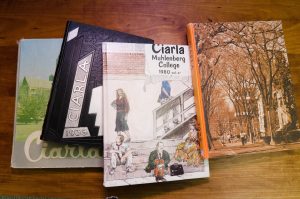The 125-year-old yearbook, the Ciarla, was doomed to be dying out until 2016 when Bea Collins, a sophomore at the time, came to its rescue. With an ongoing struggle to keep the yearbook alive, Collins and academic advisor Donna Fahringer continue to fight an uphill battle to keep the Ciarla’s existence present in Muhlenberg’s community.
Collins is now a senior and is the Editor-in-Chief of the Ciarla. Collins has been working with Donna Fahringer, Administrative Assistant for the Office of Communications, since last year when she became the new academic advisor of the organization.

With past issues such as lack of teamwork, irresponsibility and lack of student involvement, it has been a difficult run for the Ciarla. Collins and Fahringer have been working hard on recruiting students from all grade levels by spreading the yearbook’s importance and positive qualities it gives students during college and after graduation. They have strayed away from past problems and have been emphasizing the importance of what it takes to work within a team and what it takes to be responsible.
“The yearbook is the one avenue where the students get to tell the history,” said Fahringer. “Being able to have the history in a book is so much different than having it in any digital media source. Yearbooks are like coffee table conversation pieces, and they can tell the history through the student’s perspective.”
“Being able to have the history in a book is so much different than having it in any digital media source. Yearbooks are like coffee table conversation pieces, and they can tell the history through the student’s perspective.”
Although Collins and Fahringer have kept the yearbook alive, there has been an ongoing struggle to maintain students’ involvement.
“This semester we have a much more rigorous system for recruiting in place,” said Collins. “However, it’s still tough to get people to show up for meetings. I got about 40 names from the Activities Fair, and I have maybe five people show up to a meeting. One of the problems may be that the group is not a social one like the Outdoors Club. The yearbook is project-based.”
Collins’ goal for the year is to find students to take on the role of editors so that most of the content work is taken care of.
“This way I can focus primarily on teaching underclassmen how to use the system because it took me three years to learn the system on how does the book building software work. Once I’m gone there’s no one else on campus who knows the software this well so basically that’s my job/goal of this year,” said Collins.
“We want this book to be about life at Muhlenberg and allow everybody to have some skin in the game,” said Fahringer. “We want everybody to contribute and have fun with it and look forward to it coming out. One of the reasons to keep the organization alive is so that 10,15, 20 years from now when you look back and you pull your yearbook out, or you’re getting together with friends at a reunion you’re going to laugh at how you were dressed or look back on the events you were at. You will reminisce about your past time at Muhlenberg and nothing but the Ciarla yearbook can accomplish that.”
“We want this book to be about life at Muhlenberg and allow everybody to have some skin in the game,”
Not only do Collins and Fahringer want the yearbook to allow students to reminisce about the past, but they also want it to create a present-day community.
“What we’re hoping to do is not just have a small group of students create the book but to get the whole community of students of every grade and have them contribute in one way or another,” said Fahringer. “It may be writing a short article on what the Career Center Road Trips are like or writing a small article about what sororities are doing on campus, to submitting photos through the new IsImageShare app that is now available to all students and faculty.”
IsImageShare allows every individual in the Muhlenberg community to submit images. By submitting the images they go directly into the program where the editors can use it to hold their content, and they can pull the submitted images into different sections of the Ciarla.
The yearbook also allows students to gain real world experience.

“The bulk of the book is done in the second half of the year,” said Collins. “Second semester all the fall sports and Greek initiations are done. So, I do a lot of groundwork the first semester of the school year and then the second semester that is when I work on layouts. During the fall I work on recruiting members.”
“Working with the yearbook is a little snapshot of what the career world is like because the editors must come together and work cooperatively to put out an end product.” added Fahringer. “Subsequently, they all must collaborate and talk about style and design and what photos they want to put in.”






















